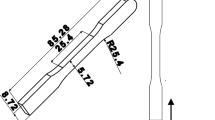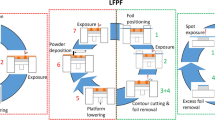Abstract
Powder bed fusion (PBF) enables the manufacturing of complex structures. While part consolidation is a widespread method of utilizing the design potentials of additive manufacturing, new approaches in research suggest a systematic separation of parts. Conclusively, separated parts must be joined after the manufacturing process. In this paper, electroplating is proposed as a joining process for PBF fabricated components. The joining by electroplating process is described and successfully used to join PBF manufactured tension rods. The influence of the joining geometry on the buildup of the joint is investigated. Furthermore, tensile strength and failure causes of the joined specimens are determined. Tensile strength for nickel joined specimens is 127.4 MPa and for copper joined specimens 83.2 MPa. Causes of failure are delamination in the zinc layer and fracture of the base body. The tool-free character of the process holds potential for joining complex geometries in PBF.
Access this chapter
Tax calculation will be finalised at checkout
Purchases are for personal use only
Similar content being viewed by others
References
Biffi, C. A., Fiocchi, J., & Tuissi, A. (2019). Laser Weldability of AlSi10Mg alloy produced by selective laser melting: microstructure and mechanical behavior. Journal of Materials Engineering and Performance, 28(11), 6714–6719. https://doi.org/10.1007/s11665-019-04402-7
Cavalcanti, D. K. K., Banea, M. D., & de Queiroz, H. F. M. (2019). Mechanical characterization of bonded joints made of additive manufactured adherends. Annals of Dunarea De Jos University of Galati Fascicle XII Welding Equipment and Technology, 30, 27–33. https://doi.org/10.35219/awet.2019.04
Deka, A., & Behdad, S. (2019). Part separation technique for assembly-based design in additive manufacturing using genetic algorithm. Procedia Manufacturing, 34, 764–771. https://doi.org/10.1016/j.promfg.2019.06.208
DIN e.V. DIN 50125:2016-12, Prüfung metallischer Werkstoffe_- Zugproben. Berlin: Beuth Verlag GmbH.
Dini, J. W., & Johnson, H. R. (1974). Joining by electroplating. Metals Engineering Quarterly, 14(1), 6–12.
Frascio, M., Jilich, M., Pizzorni, M., Monti, M., Avalle, M., & Zoppi, M. (2019). The use of low pressure plasma surface modification for bonded joints to assembly a robotic gripper designed to be additive manufactured. Procedia Structural Integrity, 24, 204–212. https://doi.org/10.1016/j.prostr.2020.02.017
Gibson, I., Rosen, D., & Stucker, B. (2015). Additive manufacturing technologies: 3D printing, rapid prototy** and direct digital manufacturing (Second Edition). Springer. https://www.loc.gov/catdir/enhancements/fy1617/2014953293-b.html.
Gill, M., Terry, E., Abdi, Y., Hawkes, S., Rindler, J., Schick, D., Ramirez, A., & Herderick, E. D. (2020). Joining technologies for metal additive manufacturing in the energy industry. JOM Journal of the Minerals Metals and Materials Society, 72(12), 4214–4220. https://doi.org/10.1007/s11837-020-04441-9
Hassanin, A. E., Velotti, C., Scherillo, F., Astarita, A., Squillace, A., & Carrino, L. (2017). Study of the solid state joining of additive manufactured components. In 2017 IEEE 3rd International Forum on Research and Technologies for Society and Industry (RTSI) (pp. 1–4). IEEE. https://doi.org/10.1109/RTSI.2017.8065967
Kanani, N. (2020). Galvanotechnik: Grundlagen, Verfahren und Praxis einer Schlüsseltechnologie (3., aktualisierte Auflage). Hanser.
Kim, S., & Moon, S. K. (2020). A part consolidation design method for additive manufacturing based on product disassembly complexity. Applied Sciences, 10(3), 1100. https://doi.org/10.3390/app10031100
Kranz, J. (2017). Methodik und Richtlinien für die Konstruktion von laseradditiv gefertigten Leichtbaustrukturen. Berlin, Heidelberg: Springer. https://doi.org/10.1007/978-3-662-55339-8.
Krause, D., & Gebhardt, N. (2018). Methodische Entwicklung Modularer Produktfamilien: Hohe Produktvielfalt Beherrschbar Entwickeln. Vieweg. https://ebookcentral.proquest.com/lib/gbv/detail.action?docID=5215463.
Krauss, W., Lorenz, J., & Konys, J. (2014). Joining of HHF materials applying electroplating technology. Fusion Engineering and Design, 89(7–8), 1213–1218. https://doi.org/10.1016/j.fusengdes.2014.04.042
Kuklik, J., Wippo, V., Jaeschke, P., Kaierle, S., & Overmeyer, L. (2020). Laser Transmission Welding of additive manufactured parts: Process modifications to reduce cavities inside the weld seam. Procedia CIRP, 94, 139–143. https://doi.org/10.1016/j.procir.2020.09.027
Kumke, M. Methodisches Konstruieren von additiv gefertigten Bauteilen [Dissertation]. Wiesbaden: Springer Fachmedien Wiesbaden.
Laverne, F., Segonds, F., Anwer, N., & Le Coq, M. (2015). Assembly based methods to support product innovation in design for additive manufacturing: An exploratory case study. Journal of Mechanical Design, 137(12), Article 121701. https://doi.org/10.1115/1.4031589.
Moeini, G., Sajadifar, S. V., Wegener, T., Brenne, F., Niendorf, T., & Böhm, S. (2019). On the low-cycle fatigue behavior of friction stir welded Al–Si12 parts produced by selective laser melting. Materials Science and Engineering: A, 764, 138189. https://doi.org/10.1016/j.msea.2019.138189
Nie, Z., Jung, S., Kara, L. B., & Whitefoot, K. S. (2020). Optimization of part consolidation for minimum production costs and time using additive manufacturing. Journal of Mechanical Design, 142(7), Article 072001. https://doi.org/10.1115/1.4045106.
Oh, Y., Zhou, C., & Behdad, S. (2018). Part decomposition and 2D batch placement in single-machine additive manufacturing systems. Journal of Manufacturing Systems, 48, 131–139. https://doi.org/10.1016/j.jmsy.2018.07.006
Pimentel, A., Noversa, T., Freitas, L., Nunes J. P., Brito, A. M., Lima, R., Alves, T. (2018). Mechanical joining methods for additive manufactured assembly tools. In Proceedings of the 8th international conference on polymers and moulds innovation—PMI 2018.
Prashanth, K. G., Damodaram, R., Maity, T., Wang, P., & Eckert, J. (2017). Friction welding of selective laser melted Ti6Al4V parts. Materials Science and Engineering: A, 704, 66–71. https://doi.org/10.1016/j.msea.2017.08.004
Ramírez, E. A., Caicedo, F., Hurel, J., Helguero, C. G., & Amaya, J. L. (2019). Methodology for design process of a snap-fit joint made by additive manufacturing. Procedia CIRP, 79, 113–118. https://doi.org/10.1016/j.procir.2019.02.021
Reichwein, J., & Kirchner, E. (2021). Part orientation and separation to reduce process costs in additive manufacturing. Proceedings of the Design Society, 1, 2399–2408. https://doi.org/10.1017/pds.2021.501
Reichwein, J., Vogel, S., Schork, S., & Kirchner, E. (2020). On the applicability of agile development methods to design for additive manufacturing. Procedia CIRP, 91, 653–658. https://doi.org/10.1016/j.procir.2020.03.112
Reichwein, J., Rudolph, K., Geis, J., & Kirchner, E. (2021a). Adapting product architecture to additive manufacturing through consolidation and separation. Procedia CIRP, 100, 79–84. https://doi.org/10.1016/j.procir.2021.05.013
Reichwein, J., Steffan, K.-E., & Eckhard, K. (2021b). Bauteiltrennung zur Reduzierung der Prozesszeit und—kosten in der Additiven Fertigung. In D. Roth (Chair), Stuttgarter Symposium für Produktentwicklung SSP 2021. Symposium conducted at the meeting of Fraunhofer—Institut für Arbeitswissenschaft und Organisation IAO, Stuttgart.
Tavlovich, B., Shirizly, A., & Katz, R. (2018). EBW and LBW of Additive Manufactured Ti6Al4V Products. Welding Journal, 97(6), 179–190. https://doi.org/10.29391/2018.97.016.
Wits, W. W., & Becker, J. J. (2015). Laser beam welding of titanium additive manufactured parts. Procedia CIRP, 28, 70–75. https://doi.org/10.1016/j.procir.2015.04.013
Wohlers, T. T. (2018). WOHLERS REPORT: 3d printing and additive manufacturing state of the industry. WOHLERS Associates.
Würtenberger, J., Reichwein, J., & Kirchner, E. (2018). Using the potentials of additive manufacturing by a systematic linkage of the manufacturing process to product design. In Design conference proceedings, proceedings of the DESIGN 2018 15th international design conference (pp. 1465–1476). Faculty of Mechanical Engineering and Naval Architecture, University of Zagreb, Croatia; The Design Society, Glasgow, UK. https://doi.org/10.21278/idc.2018.0225.
Author information
Authors and Affiliations
Corresponding author
Editor information
Editors and Affiliations
Rights and permissions
Copyright information
© 2023 The Author(s), under exclusive license to Springer Nature Switzerland AG
About this paper
Cite this paper
Rudolph, K., Noack, M., Hausmann, M., Kirchner, E., Babaei, P. (2023). Electroplating as an Innovative Joining Method for Laser Additive Manufactured Components Made of AlSi10Mg. In: Lachmayer, R., Bode, B., Kaierle, S. (eds) Innovative Product Development by Additive Manufacturing 2021. Springer, Cham. https://doi.org/10.1007/978-3-031-05918-6_11
Download citation
DOI: https://doi.org/10.1007/978-3-031-05918-6_11
Published:
Publisher Name: Springer, Cham
Print ISBN: 978-3-031-05917-9
Online ISBN: 978-3-031-05918-6
eBook Packages: EngineeringEngineering (R0)




